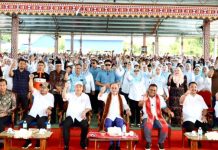KOTA KINABALU: Chief Minister Datuk Seri Panglima Haji Hajiji Haji Noor welcomed Kinabatangan’s recognition as a Biosphere Reserve under UNESCO’s Man and the Biosphere (MAB) Programme.
He said the recognition marked another significant milestone in the state’s ongoing efforts to preserve environmental sustainability and biodiversity at the global level.
The Chief Minister also said that with this globally recognised status, the Kinabatangan Biosphere Reserve is expected to attract international attention in areas such as research, education, nature-based tourism, and opportunities for global collaboration.
“The Sabah State Government will continue to strengthen biodiversity conservation efforts, expand community awareness programmes, and enhance strategic partnerships to ensure that the benefits of this recognition are widely and sustainably realised,” he added.
Hajiji said the Sabah State Cabinet endorsed the intention to nominate Kinabatangan as a Biosphere Reserve on March 30, 2022, and the nomination dossier was approved on August 7, 2024.
The selection process, which took place over two years from 2022 to 2024, was led by the Sabah Biodiversity Centre in strategic collaboration with various ministries, government departments and agencies, non-governmental organisations, industry stakeholders, and local communities.
With this designation, Kinabatangan is now the second Biosphere Reserve in Sabah after the Crocker Range Biosphere Reserve, and the fourth in Malaysia.
UNESCO officially recognised the Crocker Range Biosphere Reserve on June 12, 2014.To date, there are 759 Biosphere Reserves across 136 countries worldwide.
This prestigious recognition was declared during the 37th Session of the International Coordinating Council of the Man and the Biosphere (MAB) Programme (ICC), held on Sept 27 in Hangzhou, China.
The recognition was based on an assessment of Kinabatangan’s unique ecology, rich biodiversity, and sustainable management practices, which involve a broad range of stakeholders in the area.
Additionally, the MAB Advisory Committee of UNESCO, which conducted the preliminary evaluation, commended the high-quality nomination dossier, its clear presentation of information, and the extensive stakeholder engagement achieved through a 22-month consultation process.
The Kinabatangan Biosphere Reserve spans an area of 413,866 hectares and is a natural treasure trove rich in unique biodiversity and invaluable cultural heritage.
Stretching across 560 kilometres along the Kinabatangan River, it is a vital habitat for 315 bird species, 100 reptile species, 33 amphibian species, 127 mammal species, and more than 1,000 species of vascular plants.
The site is also home to several endemic, rare, and endangered species, including the orangutan (Pongo pygmaeus), the Bornean elephant (Elephas maximus borneensis), the proboscis monkey (Nasalis larvatus), the sun bear (Helarctos malayanus), the clouded leopard (Neofelis diardi), and eight hornbill species native to Sabah.
Notably, the recognition of the Kinabatangan Biosphere Reserve also supports the preservation of the Sungai dialect, which is currently listed as Critically Endangered in UNESCO’s Atlas of the World’s Languages in Danger. – pr/BNN






